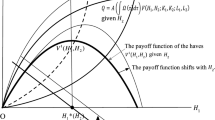Abstract
This paper examines the patterns of economic integration and endogenous growth in a two-country overlapping-generations world, in which the formation of children's human capital is financed by parents. It explores the influence of cross-border external effects in human capital on growth. Interestingly, world integration can enhance (reduce) long-run growth in both countries if cross-border external effects in human capital are sufficiently strong (weak).
Similar content being viewed by others
References
Allais, M. (1947):Economie et intérêt, Paris: Imprimerie Nationale.
Barro, R. J., Mankiw, N. G., and Sala-i-Martin, X. (1995): “Capital Mobility in Neoclassical Models of Growth.American Economic Review 85: 103–115.
Becker, G. S. (1991):A Treatise on the Family, enlarged edition. Cambridge, Mass.: Harvard University Press.
Becker, G. S., and Tomes, N. (1986): “Human Capital and the Rise and Fall of Families.”Journal of Labor Economics 4: 1–39 [reprinted in Becker, 1991].
Buiter, W. H. (1981): “Time Preference and International Lending and Borrowing in an Overlapping-generations Model.”Journal of Political Economy 89: 769–797.
Buiter, W. H., and Kletzer, K. M. (1991): “Persistent Differences in National Productivity Growth Rates with a Common Technology and Free Capital Mobility: the Roles of Private Thrift, Public Debt, Capital Taxation, and Policy Toward Human Capital Formation.”Journal of the Japanese and International Economies 5: 325–353.
— (1993): “Permanent International Productivity Growth Differentials in an Integrated Global Economy.”Scandinavian Journal of Economics 95: 467–493.
— (1995): “Capital Mobility, Fiscal Policy, and Growth under Self-financing of Human Capital Formation.”Canadian Journal of Economics, Special Issue 28: 163–194.
Caballe, J. (1995): “Endogenous Growth, Human Capital, and Bequests in a Life-cycle Model.”Oxford Economic Papers 47: 156–181.
Chamley, C. (1992): “The Last Shall Be the First: Efficient Constraints on Foreign Borrowing in a Model of Endogenous Growth.”Journal of Economic Theory 58: 335–354.
— (1993): “Externalities and Dynamics in Models of ‘Learning or Doing’.”International Economic Review 34: 583–609.
Chua, H. B. (1993): “Regional Spillovers and Economic Growth.” Economic Growth Center Discussion Paper no. 700, Yale University, New Haven, Conn.
Crettez, B., Michel, P., and Vidal, J.-P. (1996): “Time Preference and Labour Mobility in an OLG Model with Land and Capital.”Journal of Population Economics 9: 387–403.
— (1998): “Time Preference and Capital Mobility in an OLG Model with Land.”Journal of Population Economics 11: 149–158.
Diamond, P. A. (1965): “National Debt in a Neoclassical Growth Model.”American Economic Review 55: 1126–1150.
Drazen, A. (1978): “Government Debt, Human Capital, and Bequests in a Life-cycle Model.”Journal of Political Economy 86: 505–516.
Galor, O. (1986): “Time Preference and International Labor Migration.”Journal of Economic Theory 38: 1–20.
— (1992): “The Choice of Factor Mobility in a Dynamic World.”Journal of Population Economics 5: 135–144.
Glomm, G., and Ravikumar, B. (1992): “Public Versus Private Investment in Human Capital: Endogenous Growth and Income Inequality.”Journal of Political Economy 100: 818–834.
Grossman, G. M., and Helpman, E. (1991):Innovation and Growth in the Global Economy. Cambridge, Mass.: MIT Press.
Lucas, R. E. (1988): “On the Mechanics of Economic Development.”Journal of Monetary Economics 22: 3–42.
Mankiw, N. G., Romer, D., and Weil, D. N. (1992): “A Contribution to the Empirics of Economic Growth.”Quarterly Journal of Economics 107: 407–437.
Michel, P. (1993): “Le modèle à générations imbriquées: un instrument d'analyse économique.”Revue d'Economie Politique 103: 191–220.
Rangazas, P. C. (1996): “Fiscal Policy and Endogenous Growth in a Bequest-constrained Economy.”Oxford Economic Papers 48: 52–74.
Rivera-Batiz, L. A., and Romer, P. M. (1991a): “International Trade with Endogenous Technical Change.”European Economic Review 35: 971–1004.
— (1991b): “Economic Integration and Endogenous Growth.”Quarterly Journal of Economics 106: 531–555.
Samuelson, P. A. (1958): “An Exact Consumption Loan Model of Interest with or without the Social Contrivance of Money.”Journal of Political Economy 66: 467–482.
Temple, J. (1999): “A Positive Effect of Human Capital on Growth.”Economics Letters 65: 131–134.
Van der Ploeg, F., and Tang, P. (1994): “Growth, Deficits, and Research Development in the Global Economy.” InHandbook of International Macroeconomics, edited by F. Van der Ploeg. London: Blackwell.
Vidal, J.-P. (2000): “Capital Mobility in a Dynastic Framework.”Oxford Economic Papers 52: 606–625.
Author information
Authors and Affiliations
Rights and permissions
About this article
Cite this article
Michel, P., Vidal, JP. Economic integration and growth under intergenerational financing of human-capital formation. Journal of Economics Zeitschrift für Nationalökonomie 72, 275–294 (2000). https://doi.org/10.1007/BF01231268
Received:
Revised:
Issue Date:
DOI: https://doi.org/10.1007/BF01231268




